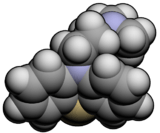Promazine
Not to be confused with Bromazine.
 | |
 | |
| Clinical data | |
|---|---|
| AHFS/Drugs.com | Micromedex Detailed Consumer Information |
| MedlinePlus | a600010 |
| ATC code | N05AA03 (WHO) |
| Pharmacokinetic data | |
| Protein binding | 94% |
| Identifiers | |
| |
| CAS Number |
58-40-2 |
| PubChem (CID) | 4926 |
| IUPHAR/BPS | 7281 |
| DrugBank |
DB00420 |
| ChemSpider |
4757 |
| UNII |
O9M39HTM5W |
| ChEBI |
CHEBI:8459 |
| ChEMBL |
CHEMBL564 |
| ECHA InfoCard | 100.000.347 |
| Chemical and physical data | |
| Formula | C17H20N2S |
| Molar mass | 284.42 g/mol |
| 3D model (Jmol) | Interactive image |
| |
| |
| (verify) | |
Promazine (Sparine) is a medication that belongs to the phenothiazine class of antipsychotics. An older medication used to treat schizophrenia, it is still prescribed, alongside newer agents such as olanzapine and quetiapine. It has predominantly anticholinergic side effects, though extrapyramidal side effects are not uncommon either.
Promazine is not approved for human use in the United States. It is available in the US for veterinary use under the names Promazine and Tranquazine.
| |||||||||||||||||
| |||||||||||||||||
| |||||||||||||||||
| |||||||||||||||||
| |||||||||||||||||
| D1-like |
| ||||||||||||||||||||||||||||||||||||||||||||||||||
|---|---|---|---|---|---|---|---|---|---|---|---|---|---|---|---|---|---|---|---|---|---|---|---|---|---|---|---|---|---|---|---|---|---|---|---|---|---|---|---|---|---|---|---|---|---|---|---|---|---|---|---|
| D2-like |
| ||||||||||||||||||||||||||||||||||||||||||||||||||
| |||||||||||||||||||||||||||||||||||||||||||||||||||
| Receptor (ligands) |
| ||||||||||||||
|---|---|---|---|---|---|---|---|---|---|---|---|---|---|---|---|
| Transporter (inhibitors) |
| ||||||||||||||
| Enzyme (inhibitors) |
| ||||||||||||||
| Others |
| ||||||||||||||
| Classes |
|
|---|---|
| Antidepressants (TCAs and TeCAs) |
|
| Antihistamines |
|
| Antipsychotics |
|
| Anticonvulsants | |
| Others |
|
This article is issued from Wikipedia - version of the 6/23/2016. The text is available under the Creative Commons Attribution/Share Alike but additional terms may apply for the media files.